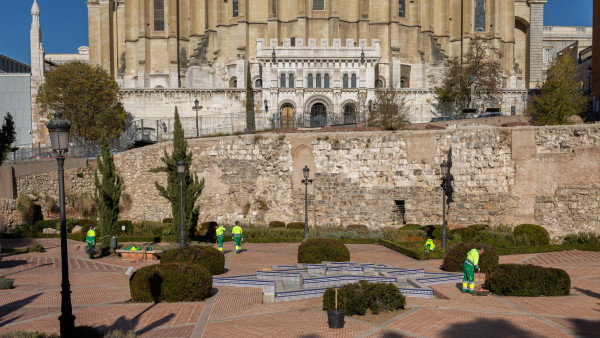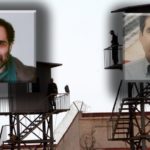While armchair enthusiasts of European history are well aware of southern Spain’s Islamic history, most are unaware that Madrid, Spain’s current capital, once had a distinct Islamic footprint. Yet, after centuries of neglect, few relics remain.
Unexpectedly wedged between vehicles in an underground car park lie the remnants of Madrid’s forgotten past. Encased in glass are the remains of an Islamic watchtower dating back to the 10th Century, providing clues to the city’s Muslim heritage.
Madrid is, unbeknownst to many, the only European capital with Islamic roots. Founded as Mayrit around 865 by Umayyad emir Mohamed I, it was established as part of a chain of fortified military settlements to defend the northern border of the Islamic Empire of Al-Andalus from Christian kingdoms.
“The declaration of Madrid as the capital put an end to the peaceful coexistence. It was not in the interest of the rest of the Spanish Empire to show that Madrid was of Islamic origin, since they wanted to create and consolidate a genuinely Catholic empire and claim the end of Al-Andalus”
Mayrit remained part of Al-Andalus for over two centuries, growing and developing beyond its military role into a prosperous town. It grew to become a regional capital with its own judge and mosque, which attracted the surrounding population to gather for Friday prayers.
“It was a second or third-grade city within Al-Andalus, which means that it was not simply a military settlement. It was a small and well-known city especially because it was in a strategic region and military expeditions passed through Madrid or its surroundings, and that’s what made the city so important,” says Daniel Gil-Benumeya, Arabist historian and coordinator of the Centre for the Study of Islamic Madrid (CEMI).
The watchtower ruins serve as an apt metaphor for the mark left behind. Unnoticed and all but forgotten, in a car park one storey underground and kept relatively out of the way. Reduced primarily to a minor point of interest that many are simply unaware of.
Centuries of peaceful coexistence
It was not until 1085 that the city’s ownership changed hands when the Catholic king Alfonso VI conquered Mayrit.
Despite the conquest, the city’s new Catholic rulers respected Mayrit’s Islamic roots and fostered a peaceful coexistence between the city’s Muslim community and their new Catholic neighbours which lasted over 500 years.
According to Gil-Benumeya, the city’s Muslim community during the Catholic rule never grew beyond the five percent mark and was concentrated mainly in specific neighbourhoods – known as morerías. Nonetheless, the community held significant political importance.
“According to laws in place throughout the Kingdom of Castile, Muslims and Jews could not hold public office. Yet in Madrid there existed a public position equivalent to councillor for urbanism, which for centuries was held by Muslims, despite the fact that it was not legal,” Gil-Benumeya tells The New Arab.
The city’s Muslim community also held social and economic strength, particularly in the blacksmithing and construction industries. So much so, in fact, that the first-ever recorded strike in the city’s history was organised by Muslim blacksmiths in opposition to segregation and relocation measures proposed by the Catholics in 1482.
Eventually, in 1502, Spain’s Catholic rulers chose to expel the country’s Muslim population and offered the group a simple option: convert or leave. Thus, the Islamic community saw itself dwindle in size and strength.
Limited visible traces
Nowadays little is felt of the centuries worth of Islamic heritage. That is no accident, as in 1561 the Catholic king Philip II named Madrid the capital of the Spanish Empire.
As the headquarters of the globe’s largest Catholic empire at the time, the city had to reflect its newly found status and do away with any indication of its Muslim past.
“The Islamic memory of Madrid has almost disappeared, and the remains are few, apart from the wall and other archaeological remains”
“The declaration of Madrid as the capital put an end to the peaceful coexistence. It was not in the interest of the rest of the Spanish Empire to show that Madrid was of Islamic origin since they wanted to create and consolidate a genuinely Catholic empire and claim the end of Al-Andalus.
“Therefore, it was necessary to make the material Islamic past disappear from the city and invent myths about its conquest, in accordance with the new religion,” explains Encarna Gutierrez, the secretary-general of Spain’s Islamic Culture Foundation (FUNCI).
Nonetheless, evidence can still be found. The remains of a ninth-century wall, part of the original fortifications erected by the city’s Muslim founders, lie in the Emir Mohamed park, overshadowed by the neighbouring Almudena Cathedral – the biggest in the city.
Five minutes up the road is the grandiose Royal Palace, which itself is built on the site of an old ninth-century Moorish citadel that was destroyed by a fire in the mid-18th Century.
The most evident reminder of Madrid’s Muslim past lies in the architectural clues one can find dotted throughout the city centre.
The Muslim dominance of the medieval construction industry bred its own distinct architectural style known as the Mudéjar style. It fuses traditional Renaissance design with Islamic influence and ornamental elements.
Madrid’s second oldest church, the church of San Pedro el Viejo, as well as the nearby Plaza de la Villa are prime examples of Mudéjar architecture and the enduring impact the Muslim past has had on the city.
Additionally, even the city’s patron saint – San Isidro – is also believed to have been a Muslim holy man whose Spanish name derives from the Arabic name Driss.
Social neglect
The eradication of Madrid’s Islamic past also fostered a degree of societal disdain and rejection of the Muslim community which has endured to this day.
“In Madrid, as in all of Spain and Europe, there is structural racism that is directed at people who are perceived as foreigners but especially towards Muslims. This racist discourse is based on the idea that these people, cultures and languages are foreign.
“The perception is usually negative, but even when a positive view is given, it always comes from the point of view of ‘well, they were foreigners who were here for a while and left some good things, but they are not our ancestors. I am very interested in the links that can be established between the past and the present to dismantle these essentialist discourses,” Gil-Benumeya tells The New Arab.
Through the work of organisations such as the CEMI and the FUNCI, Gutierrez and Gil-Benumya hope to bring Madrid’s hidden past to life and weave a more representative social fibre in the process.
“The Islamic memory of Madrid has almost disappeared, and the remains are few apart from the wall and other archaeological remains. Without their historical and cultural memory, a people cannot achieve their necessary self-esteem and freedom,” says Gutierrez.
By: Inigo Alexander – a freelance journalist whose work focuses on Spain, Latin America and social justice. His work has appeared in The Guardian, The Daily Telegraph, The Local, NACLA, among others
Follow him on Twitter: @Inigo_Alexander
Source: the New Arab
***Show us some LOVE by sharing it!***



